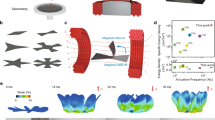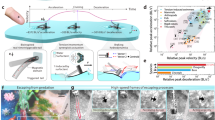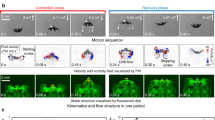Abstract
Small-scale magnetic soft-bodied robots can be designed to operate based on different locomotion modes to navigate and function inside unstructured, confined and varying environments. These soft millirobots may be useful for medical applications where the robots are tasked with moving inside the human body. Here we cover the entire process of developing small-scale magnetic soft-bodied millirobots with multimodal locomotion capability, including robot design, material preparation, robot fabrication, locomotion control and locomotion optimization. We describe in detail the design, fabrication and control of a sheet-shaped soft millirobot with 12 different locomotion modes for traversing different terrains, an ephyra jellyfish-inspired soft millirobot that can manipulate objects in liquids through various swimming modes, a larval zebrafish-inspired soft millirobot that can adjust its body stiffness for efficient propulsion in different swimming speeds and a dual stimuli-responsive sheet-shaped soft millirobot that can switch its locomotion modes automatically by responding to changes in the environmental temperature. The procedure is aimed at users with basic expertise in soft robot development. The procedure requires from a few days to several weeks to complete, depending on the degree of characterization required.
Key points
-
The protocol describes a sheet-shaped millirobot with 12 locomotion modes for traversing different terrains, a jellyfish-inspired millirobot for manipulating objects in liquids, a zebrafish-inspired millirobot for efficient swimming and a dual stimuli-responsive millirobot that can switch locomotion modes automatically by responding to the environmental temperature.
-
Rigid-bodied robots lack deformation capabilities, limiting them to specific functions, whereas soft-bodied millibots display sophisticated locomotion strategies similar to those adopted by small-scale organisms.
This is a preview of subscription content, access via your institution
Access options
Access Nature and 54 other Nature Portfolio journals
Get Nature+, our best-value online-access subscription
$29.99 / 30 days
cancel any time
Subscribe to this journal
Receive 12 print issues and online access
$259.00 per year
only $21.58 per issue
Buy this article
- Purchase on Springer Link
- Instant access to full article PDF
Prices may be subject to local taxes which are calculated during checkout


















Similar content being viewed by others
Code availability
The codes used for locomotion performance evaluation and optimization has been published in our previous papers and are available from the corresponding author on reasonable request.
References
Sitti, M. et al. Biomedical applications of untethered mobile milli/microrobots. Proc. IEEE. 103, 205–224 (2015).
Nelson, B. J., Kaliakatsos, I. K. & Abbott, J. J. Microrobots for minimally invasive medicine. Annu. Rev. Biomed. Eng. 12, 55–85 (2010).
Wu, Z. et al. A swarm of slippery micropropellers penetrates the vitreous body of the eye. Sci. Adv. 4, eaat4388 (2018).
Sitti, M. Mobile Microrobotics (MIT Press, 2017).
Ceylan, H., Yasa, I. C., Kilic, U., Hu, W. Q. & Sitti, M. Translational prospects of untethered medical microrobots. Prog. Biomed. Eng. https://doi.org/10.1088/2516-1091/ab22d5 (2019).
Han, M. D. et al. Submillimeter-scale multimaterial terrestrial robots. Sci. Robot. https://doi.org/10.1126/scirobotics.abn0602 (2022).
Shahsavan, H. et al. Bioinspired underwater locomotion of light-driven liquid crystal gels. Proc. Natl Acad. Sci. USA 117, 5125–5133 (2020).
Aghakhani, A., Yasa, O., Wrede, P. & Sitti, M. Acoustically powered surface-slipping mobile microrobots. Proc. Natl Acad. Sci. USA 117, 3469–3477 (2020).
Dillinger, C., Nama, N. & Ahmed, D. Ultrasound-activated ciliary bands for microrobotic systems inspired by starfish. Nat. Commun. 12, 1–11 (2021).
Lum, G. Z. et al. Shape-programmable magnetic soft matter. Proc. Natl Acad. Sci. USA 113, E6007–E6015 (2016).
Zhang, L. et al. Artificial bacterial flagella: fabrication and magnetic control. Appl. Phys. Lett. 94, 064107 (2009).
Li, M., Pal, A., Aghakhani, A., Pena-Francesch, A. & Sitti, M. Soft actuators for real-world applications. Nat. Rev. Mater. 7, 235–249 (2022).
Sitti, M. Physical intelligence as a new paradigm. Extreme Mech. Lett. https://doi.org/10.1016/j.eml.2021.101340 (2021).
Hu, W., Lum, G. Z., Mastrangeli, M. & Sitti, M. Small-scale soft-bodied robot with multimodal locomotion. Nature 554, 81–85 (2018).
Ren, Z. et al. Soft-bodied adaptive multimodal locomotion strategies in fluid-filled confined spaces. Sci. Adv. 7, eabh2022 (2021).
Wu, Y. D., Dong, X. G., Kim, J. K., Wang, C. X. & Sitti, M. Wireless soft millirobots for climbing three-dimensional surfaces in confined spaces. Sci. Adv. https://doi.org/10.1126/sciadv.abn3431 (2022).
Demir, S. O. et al. Task space adaptation via the learning of gait controllers of magnetic soft millirobots. Int. J. Robot. Res. 40, 1331–1351 (2021).
Ren, Z., Hu, W., Dong, X. & Sitti, M. Multi-functional soft-bodied jellyfish-like swimming. Nat. Commun. 10, 2703 (2019).
Wang, T., Ren, Z., Hu, W., Li, M. & Sitti, M. Effect of body stiffness distribution on larval fish-like efficient undulatory swimming. Sci. Adv. 7, eabf7364 (2021).
Zhang, J. et al. Liquid crystal elastomer-based magnetic composite films for reconfigurable shape-morphing soft miniature machines. Adv. Mater. 33, e2006191 (2021).
Sun, M. et al. Exploiting ferrofluidic wetting for miniature soft machines. Nat. Commun. 13, 7919 (2022).
Ze, Q. et al. Spinning-enabled wireless amphibious origami millirobot. Nat. Commun. 13, 3118 (2022).
Huang, H.-W. et al. Adaptive locomotion of artificial microswimmers. Sci. Adv. 5, eaau1532 (2019).
Xu, C., Yang, Z., Tan, S. W. K., Li, J. & Lum, G. Z. Magnetic miniature actuators with six‐degrees‐of‐freedom multimodal soft‐bodied locomotion. Adv. Intell. Syst. 4, 2100259 (2022).
Li, S. et al. Soft magnetic microrobot doped with porous silica for stability-enhanced multimodal locomotion in a nonideal environment. ACS Appl. Mater. Interfaces 14, 10856–10874 (2022).
Ju, Y. et al. Reconfigurable magnetic soft robots with multimodal locomotion. Nano Energy 87, 106169 (2021).
Huang, H., Feng, Y., Yang, X., Yang, L. & Shen, Y. An insect-inspired terrains-adaptive soft millirobot with multimodal locomotion and transportation capability. Micromachines 13, 1578 (2022).
Joyee, E. B., Szmelter, A., Eddington, D. & Pan, Y. 3D printed biomimetic soft robot with multimodal locomotion and multifunctionality. Soft Robot. 9, 1–13 (2022).
Du, X. M. et al. Reconfiguration, camouflage, and color-shifting for bioinspired adaptive hydrogel-based millirobots. Adv. Funct. Mater. https://doi.org/10.1002/adfm.201909202 (2020).
Diller, E., Giltinan, J., Lum, G. Z., Ye, Z. & Sitti, M. Six-degree-of-freedom magnetic actuation for wireless microrobotics. Int. J. Robot. Res. 35, 114–128 (2016).
Kim, Y., Yuk, H., Zhao, R., Chester, S. A. & Zhao, X. Printing ferromagnetic domains for untethered fast-transforming soft materials. Nature 558, 274–279 (2018).
Xu, T., Zhang, J., Salehizadeh, M., Onaizah, O. & Diller, E. Millimeter-scale flexible robots with programmable three-dimensional magnetization and motions. Sci. Robot. 4, eaav4494 (2019).
Saver, J. L. et al. Thrombectomy for distal, medium vessel occlusions a consensus statement on present knowledge and promising directions. Stroke 51, 2872–2884 (2020).
Binhas, M., Motamed, C., Hawajri, N., Yiou, R. & Marty, J. Predictors of catheter-related bladder discomfort in the post-anaesthesia care unit. Ann. Fr. Anesth. 30, 122–125 (2011).
Bai, Y. J. et al. Management of catheter-related bladder discomfort in patients who underwent elective surgery. J. Endourol. 29, 640–649 (2015).
Lucas, K. N. et al. Bending rules for animal propulsion. Nat. Commun. 5, 3293 (2014).
Zhang, J. et al. Voxelated three-dimensional miniature magnetic soft machines via multimaterial heterogeneous assembly. Sci. Robot. 6, eabf0112 (2021).
Xu, T. T. et al. Multimodal locomotion control of needle-like microrobots assembled by ferromagnetic nanoparticles. IEEE ASMA Trans. Mechatron. 27, 4327–4338 (2022).
Yu, S. et al. Trimer-like microrobots with multimodal locomotion and reconfigurable capabilities. Mater. Today Adv. https://doi.org/10.1016/j.mtadv.2022.100231 (2022).
Chen, X., Tian, C. Y., Zhang, H. & Xie, H. Biodegradable magnetic hydrogel robot with multimodal locomotion for targeted cargo delivery. ACS Appl. Mater. Interfaces 15, 28922–28932 (2023).
Ramos-Sebastian, A., Lee, J. S. & Kim, S. H. Multimodal locomotion of magnetic droplet robots using orthogonal pairs of coils. Adv. Intell. Syst. https://doi.org/10.1002/aisy.202300133 (2023).
Xie, H. et al. Reconfigurable magnetic microrobot swarm: Multimode transformation, locomotion, and manipulation. Sci. Robot. 4, eaav8006 (2019).
Zhang, R., Wu, S., Ze, Q. & Zhao, R. Micromechanics study on actuation efficiency of hard-magnetic soft active materials. J. Appl. Mech. 87, 091008 (2020).
Wang, T. et al. Adaptive wireless millirobotic locomotion into distal vasculature. Nat. Commun 13, 4465 (2022).
Alapan, Y., Karacakol, A. C., Guzelhan, S. N., Isik, I. & Sitti, M. Reprogrammable shape morphing of magnetic soft machines. Sci. Adv. https://doi.org/10.1126/sciadv.abc6414 (2020).
Alapan, Y., Bozuyuk, U., Erkoc, P., Karacakol, A. C. & Sitti, M. Multifunctional surface microrollers for targeted cargo delivery in physiological blood flow. Sci. Robot. 5, eaba5726 (2020).
Bozuyuk, U., Alapan, Y., Aghakhani, A., Yunusa, M. & Sitti, M. Shape anisotropy-governed locomotion of surface microrollers on vessel-like microtopographies against physiological flows. Proc. Natl Acad. Sci. USA https://doi.org/10.1073/pnas.2022090118 (2021).
Bozuyuk, U. et al. Reduced rotational flows enable the translation of surface-rolling microrobots in confined spaces. Nat. Commun. https://doi.org/10.1038/s41467-022-34023-z (2022).
Wang, W. D. et al. Order and information in the patterns of spinning magnetic micro-disks at the air-water interface. Sci. Adv. https://doi.org/10.1126/sciadv.abk0685 (2022).
Gardi, G., Ceron, S., Wang, W. D., Petersen, K. & Sitti, M. Microrobot collectives with reconfigurable morphologies, behaviors, and functions. Nat. Commun. https://doi.org/10.1038/s41467-022-29882-5 (2022).
Hu, X. H. et al. Magnetic soft micromachines made of linked microactuator networks. Sci. Adv. https://doi.org/10.1126/sciadv.abe8436 (2021).
Goudu, S. R. et al. Biodegradable untethered magnetic hydrogel milli-grippers. Adv. Funct. Mater. 30, 2004975 (2020).
Fan, X. J., Dong, X. G., Karacakol, A. C., Xie, H. & Sitti, M. Reconfigurable multifunctional ferrofluid droplet robots. Proc. Natl Acad. Sci. USA 117, 27916–27926 (2020).
Giltinan, J., Sridhar, V., Bozuyuk, U., Sheehan, D. & Sitti, M. 3D microprinting of iron platinum nanoparticle‐based magnetic mobile microrobots. Adv. Intell. Syst. 3, 2000204 (2021).
Zhang, S. Z. et al. 3D-printed micrometer-scale wireless magnetic cilia with metachronal programmability. Sci. Adv. https://doi.org/10.1126/sciadv.adf9462 (2023).
Bozuyuk, U. et al. High-performance magnetic FePt (L1(0)) surface microrollers towards medical imaging-guided endovascular delivery applications. Adv. Funct. Mater. https://doi.org/10.1002/adfm.202109741 (2022).
Ren, L. L., Zeng, X. L., Sun, R., Xu, J. B. & Wong, C. P. Spray-assisted assembled spherical boron nitride as fillers for polymers with enhanced thermally conductivity. Chem: Eng. J. 370, 166–175 (2019).
Guan, S. W., Su, Z. R., Chen, F. & Fu, Q. Spherical hybrid filler BN@Al2O3 via chemical adhesive for enhancing thermal conductivity and processability of silicon rubber. J. Appl. Polym. Sci. https://doi.org/10.1002/app.51211 (2021).
Zheng, Z. Q. et al. Programmable aniso-electrodeposited modular hydrogel microrobots. Sci. Adv. https://doi.org/10.1126/sciadv.ade6135 (2022).
Ceylan, H. et al. 3D-printed biodegradable microswimmer for theranostic cargo delivery and release. ACS Nano 13, 3353–3362 (2019).
Wang, X. P. et al. 3D printed enzymatically biodegradable soft helical microswimmers. Adv. Funct. Mater. https://doi.org/10.1002/adfm.201804107 (2018).
Pena-Francesch, A., Jung, H. H., Demirel, M. C. & Sitti, M. Biosynthetic self-healing materials for soft machines. Nat. Mater. 19, 1230–1235 (2020).
Pena-Francesch, A., Giltinan, J. & Sitti, M. Multifunctional and biodegradable self-propelled protein motors. Nat. Commun. https://doi.org/10.1038/s41467-019-11141-9 (2019).
Ceylan, H. et al. 3D printed personalized magnetic micromachines from patient blood-derived biomaterials. Sci. Adv. https://doi.org/10.1126/sciadv.abh0273 (2021).
Zhang, J., Soon, R. H., Wei, Z., Hu, W. & Sitti, M. Liquid metal–elastomer composites with dual-energy transmission mode for multifunctional miniature untethered magnetic robots. Adv. Sci. https://doi.org/10.1002/advs.202203730 (2022).
Ze, Q. J. et al. Magnetic shape memory polymers with integrated multifunctional shape manipulation. Adv. Mater. https://doi.org/10.1002/adma.201906657 (2020).
Zhang, J., Guo, Y., Hu, W. & Sitti, M. Wirelessly actuated thermo- and magneto-responsive soft bimorph materials with programmable shape-morphing. Adv. Mater. 33, e2100336 (2021).
Davidson, Z. S. et al. Monolithic shape-programmable dielectric liquid crystal elastomer actuators. Sci. Adv. https://doi.org/10.1126/sciadv.aay0855 (2019).
Tang, Y. et al. Wireless miniature magnetic phase-change soft actuators. Adv. Mater. https://doi.org/10.1002/adma.202204185 (2022).
Wang, L. et al. Evolutionary design of magnetic soft continuum robots. Proc. Natl Acad. Sci. USA https://doi.org/10.1073/pnas.2021922118 (2021).
Lloyd, P. et al. A learnt approach for the design of magnetically actuated shape forming soft tentacle robots. IEEE Robot. Autom. Lett. 5, 3937–3944 (2020).
Pittiglio, G. et al. Patient-specific magnetic catheters for atraumatic autonomous endoscopy. Soft Robot. 9, 1120–1133 (2022).
Wu, S. et al. Evolutionary algorithm-guided voxel-encoding printing of functional hard-magnetic soft active materials. Adv. Intell. Syst. https://doi.org/10.1002/aisy.202000060 (2020).
Dong, X. et al. Bioinspired cilia arrays with programmable nonreciprocal motion and metachronal coordination. Sci. Adv. 6, eabc9323 (2020).
Ren, Z., Wang, T., Hu, W. & Sitti, M. in A magnetically-actuated untethered jellyfish-inspired soft milliswimmer. In Proc. Robotics: Science and Systems (2019).
Cui, J. et al. Nanomagnetic encoding of shape-morphing micromachines. Nature 575, 164–168 (2019).
Liu, Z. et al. Creating three-dimensional magnetic functional microdevices via molding-integrated direct laser writing. Nat. Commun. 13, 2016 (2022).
Kummer, M. P. et al. OctoMag: an electromagnetic system for 5-DOF wireless micromanipulation. IEEE Trans. Robot. 26, 1006–1017 (2010).
Petruska, A. J. & Abbott, J. J. Optimal permanent-magnet geometries for dipole field approximation. IEEE Trans. Magnet. 49, 811–819 (2013).
Kim, Y. et al. Telerobotic neurovascular interventions with magnetic manipulation. Sci. Robot. https://doi.org/10.5061/dryad.8pk0p2nq8 (2022).
Hong, C. et al. Magnetically actuated gearbox for the wireless control of millimeter-scale robots. Sci. Robot. 7, eabo4401 (2022).
Wang, T. L., Hu, W. Q., Ren, Z. Y. & Sitti, M. Ultrasound-guided wireless tubular robotic anchoring system. IEEE Robot. Autom. Lett. 5, 4859–4866 (2020).
Wang, C., Wu, Y., Dong, X., Armacki, M. & Sitti, M. In situ sensing physiological properties of biological tissues using wireless miniature soft robots. Sci. Adv. https://doi.org/10.1126/sciadv.adg398 (2023).
Hines, L., Arabagi, V. & Sitti, M. Shape memory polymer-based flexure stiffness control in a miniature flapping-wing robot. IEEE Trans. Robot. 28, 987–990 (2012).
Thomas, T. L., Bos, J., Huaroto, J. J., Kalpathy Venkiteswaran, V. & Misra, S. A magnetically actuated variable stiffness manipulator based on deployable shape memory polymer springs. Adv. Intell. Syst. https://doi.org/10.1002/aisy.202200465 (2023).
Culha, U., Demir, S. O., Trimpe, S. & Sitti, M. Learning of sub-optimal gait controllers for magnetic walking soft millirobots. In Proc. Robotics: Science and Systems Xvi (2020).
GPy. GPy: a Gaussian process framework in python. Github http://github.com/SheffieldML/GPy (2012).
Thurston, J. NCRP Report No. 160. Ionizing Radiation Exposure of the Population of the United States (IOP Publishing, 2010).
Deng, H. et al. Laser reprogramming magnetic anisotropy in soft composites for reconfigurable 3D shaping. Nat. Commun. 11, 6325 (2020).
Zhu, H. L., He, Y. F., Wang, Y., Zhao, Y. & Jiang, C. Mechanically-guided 4D printing of magnetoresponsive soft materials across different length scale. Adv. Intell. Syst. https://doi.org/10.1002/aisy.202100137 (2022).
Tang, J. D. et al. 3D printable, tough, magnetic hydrogels with programmed magnetization for fast actuation. J. Mater. Chem. B 9, 9183–9190 (2021).
Zhang, Y. X. et al. 4D printing of magnetoactive soft materials for on-demand magnetic actuation transformation. ACS Appl. Mater. Interfaces 13, 4174–4184 (2021).
Ke, X. et al. Flexible discretely-magnetized configurable soft robots via laser-tuned selective transfer printing of anisotropic ferromagnetic cells. Mater. Today Phys. https://doi.org/10.1016/j.mtphys.2020.100313 (2021).
Zhu, H. L., Wang, Y., Ge, Y. W., Zhao, Y. & Jiang, C. Kirigami-inspired programmable soft magnetoresponsive actuators with versatile morphing modes. Adv. Sci. https://doi.org/10.1002/advs.202203711 (2022).
Li, R. et al. Magnetically encoded 3D mesostructure with high-order shape morphing and high-frequency actuation. Natl Sci. Rev. https://doi.org/10.1093/nsr/nwac163 (2022).
Dong, Y. et al. Untethered small-scale magnetic soft robot with programmable magnetization and integrated multifunctional modules. Sci. Adv. https://doi.org/10.1126/sciadv.abn8932 (2022).
Yi, S. Z. et al. High-throughput fabrication of soft magneto-origami machines. Nat. Commun. https://doi.org/10.1038/s41467-022-31900-5 (2022).
Sun, B. N. et al. Magnetic arthropod millirobots fabricated by 3D-printed hydrogels. Adv. Intell. Syst. https://doi.org/10.1002/aisy.202100139 (2022).
Sun, Y. X. et al. 3D printing of thermosets with diverse rheological and functional applicabilities. Nat. Commun. https://doi.org/10.1038/s41467-023-35929-y (2023).
Ansari, M. H. D. et al. 3D printing of small-scale soft robots with programmable magnetization. Adv. Funct. Mater. https://doi.org/10.1002/adfm.202211918 (2023).
Li, Z. X., Lai, Y. P. & Diller, E. 3D printing of multilayer magnetic miniature soft robots with programmable magnetization. Adv. Intell. Syst. https://doi.org/10.1002/aisy.202300052 (2023).
Zhang, J. & Diller, E. Untethered miniature soft robots: modeling and design of a millimeter-scale swimming magnetic sheet. Soft Robot. 5, 761–776 (2018).
Soon, R. H. et al. On-demand anchoring of wireless soft miniature robots on soft surfaces. Proc. Natl Acad. Sci. USA https://doi.org/10.1073/pnas.2207767119 (2022).
Acknowledgements
We thank the Max Planck Society, European Research Council Advanced Grant SoMMoR project (grant no. 834531) and the German Research Foundation Soft Material Robotic Systems (SPP 2100) Program (grant no. 497562474) for funding this project.
Author information
Authors and Affiliations
Contributions
Z.R. planned and prepared the manuscript. M.S. planned, supervised and edited the manuscript.
Corresponding author
Ethics declarations
Competing interests
The authors declare no competing interests.
Peer review
Peer review information
Nature Protocols thanks Chao Jiang and the other, anonymous, reviewer(s) for their contribution to the peer review process of this work.
Additional information
Publisher’s note Springer Nature remains neutral with regard to jurisdictional claims in published maps and institutional affiliations.
Related links
Key references
Hu, W. et al. Nature 554, 81–85 (2018): https://doi.org/10.1038/nature25443
Ren, Z. et al. Sci. Adv. 7, eabh2022 (2021): https://doi.org/10.1126/sciadv.abh2022
Ren, Z. et al. Nat. Commun. 10, 2703 (2019): https://doi.org/10.1038/s41467-019-10549-7
Wang, T. et al. Sci. Adv. 7, eabf7364 (2021): https://doi.org/10.1126/sciadv.abf7364
Zhang, J. et al. (2021). Adv. Mater. 33, 2006191 (2021): https://doi.org/10.1002/adma.202006191
Rights and permissions
Springer Nature or its licensor (e.g. a society or other partner) holds exclusive rights to this article under a publishing agreement with the author(s) or other rightsholder(s); author self-archiving of the accepted manuscript version of this article is solely governed by the terms of such publishing agreement and applicable law.
About this article
Cite this article
Ren, Z., Sitti, M. Design and build of small-scale magnetic soft-bodied robots with multimodal locomotion. Nat Protoc 19, 441–486 (2024). https://doi.org/10.1038/s41596-023-00916-6
Received:
Accepted:
Published:
Issue Date:
DOI: https://doi.org/10.1038/s41596-023-00916-6
This article is cited by
-
Clinical translation of wireless soft robotic medical devices
Nature Reviews Bioengineering (2024)
Comments
By submitting a comment you agree to abide by our Terms and Community Guidelines. If you find something abusive or that does not comply with our terms or guidelines please flag it as inappropriate.



